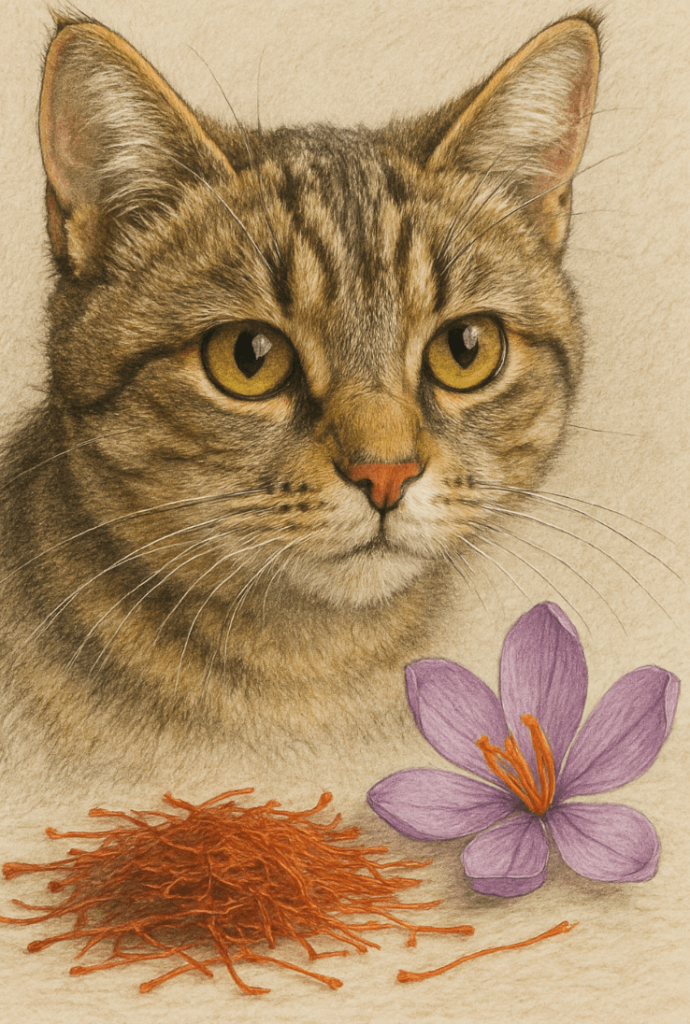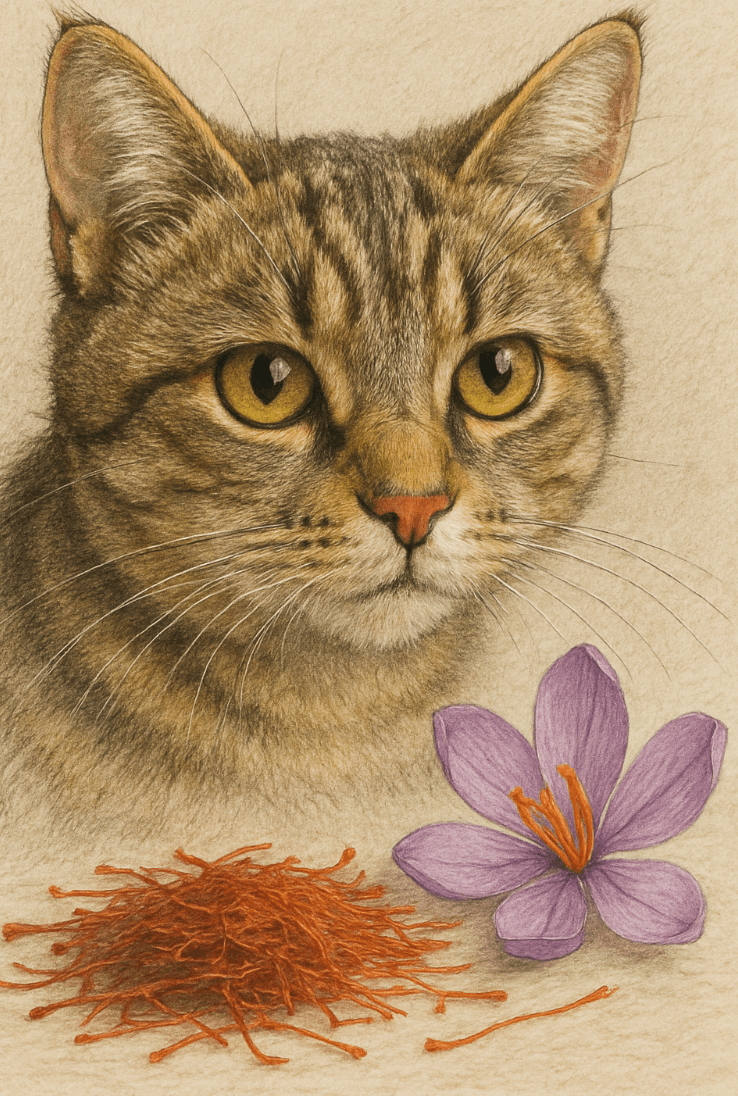Can Cats Eat Saffron?
Saffron, the luxurious golden spice known for its vibrant color and distinct flavor, is a staple in many kitchens worldwide. However, when it comes to our feline friends, curiosity often arises about whether this prized ingredient is safe for cats. While saffron is generally considered safe for humans in moderation, cats have unique dietary needs and sensitivities that require careful consideration. Understanding the potential risks and benefits of feeding saffron to your cat is essential to ensure their health and well-being. In this blog post, we’ll explore everything you need to know about cats and saffron, from its effects on their bodies to safer alternatives for treating your pet.
Potential Risks of Feeding Saffron to Cats
While saffron is not inherently toxic to cats, it can still pose risks if consumed in large quantities or without proper supervision. Here are some potential dangers to be aware of before offering saffron to your feline friend.
Digestive Upset:
Cats may experience vomiting, diarrhea, or stomach discomfort after consuming saffron due to its strong compounds.Allergic Reactions:
Some cats may develop allergic reactions, such as itching, swelling, or respiratory issues, after ingesting saffron.Toxicity in High Doses:
Large amounts of saffron can be toxic to cats, potentially leading to symptoms like lethargy, tremors, or even seizures.Impact on Liver Health:
Saffron contains compounds that may strain a cat’s liver if consumed regularly or in excess.Interference with Medications:
If your cat is on medication, saffron could interact negatively, affecting its efficacy or causing adverse effects.
These risks highlight why caution is essential when introducing saffron—or any human food—to your cat’s diet. Always prioritize their safety over experimentation.
Signs Your Cat May Have Eaten Saffron
If your cat accidentally consumes saffron, it’s important to recognize the signs early to address any potential issues promptly. Watch for these symptoms to determine if they’ve had an adverse reaction.
Vomiting or Diarrhea:
These are common signs of digestive distress caused by unfamiliar or harmful substances like saffron.Lethargy or Weakness:
A sudden lack of energy or unusual fatigue may indicate poisoning or toxicity.Excessive Drooling:
Drooling can signal nausea or irritation in the mouth or throat after consuming saffron.Difficulty Breathing:
Respiratory issues may arise if your cat has an allergic reaction or suffers from saffron toxicity.Behavioral Changes:
Restlessness, agitation, or unusual hiding behaviors could suggest discomfort or illness.
Recognizing these signs early allows you to act quickly, ensuring your cat receives the care they need to recover safely.
Check this guide 👉Can Cats Eat Cinnamon? Best 7 Expert Tips!
Check this guide 👉Can Cats Eat Tripe? Best 7 Expert Tips!
Check this guide 👉Can Cats Eat Oxtail? Best 7 Expert Tips!

Safe Alternatives to Saffron for Cats | Risks of Unsafe Spices for Cats |
|---|---|
Plain cooked chicken (unseasoned) | Garlic and onion powder (toxic to cats) |
Pumpkin puree (plain, no spices) | Nutmeg (can cause hallucinations) |
Cat-safe herbs like catnip or parsley | Cinnamon (may irritate the respiratory system) |
Bone broth (unsalted and unseasoned) | Chili powder (causes digestive upset) |
Small amounts of plain yogurt | Curry powder (contains harmful spices) |
How to Safely Introduce New Foods to Your Cat
If you’re curious about offering new foods to your cat, including spices like saffron, it’s crucial to follow a cautious approach. These tips will help you minimize risks while exploring your cat’s palate.
Consult Your Veterinarian First:
Always seek professional advice before introducing unfamiliar foods to your cat’s diet.Start with Tiny Portions:
Offer only a minuscule amount of the new food to gauge your cat’s reaction before proceeding further.Monitor for Adverse Reactions:
Observe your cat closely for signs of discomfort, allergies, or digestive issues after trying something new.Avoid Seasonings and Additives:
Stick to plain, unseasoned foods to prevent exposing your cat to harmful ingredients.Stick to Cat-Specific Treats:
Opt for treats specifically formulated for cats, as they are designed to meet their nutritional needs safely.
By following these guidelines, you can ensure your cat enjoys variety in their diet without compromising their health.
Benefits of Avoiding Spices Like Saffron for Cats
While saffron may seem harmless in small amounts, avoiding spices altogether is often the safest choice for your cat’s long-term health. Here’s why steering clear of spices benefits your feline companion.
Prevents Digestive Issues:
Cats have sensitive digestive systems, and spices can disrupt their natural balance, leading to discomfort.Reduces Risk of Allergies:
Many spices contain compounds that cats are not biologically equipped to process, increasing allergy risks.Maintains Kidney and Liver Health:
Avoiding spices reduces the strain on your cat’s vital organs, promoting better overall health.Encourages Natural Eating Habits:
Cats thrive on species-appropriate diets; avoiding spices ensures they consume what their bodies are designed to handle.Eliminates Toxicity Concerns:
By skipping spices like saffron, you eliminate the risk of accidental poisoning or adverse reactions.
Choosing simplicity over complexity keeps your cat’s diet safe, nutritious, and tailored to their needs.
Common Mistakes to Avoid When Feeding Cats Human Food
Feeding cats human food can be tempting, but certain mistakes can jeopardize their health. Avoid these pitfalls to keep your cat safe and satisfied.
Assuming All “Natural” Foods Are Safe:
Just because a food is natural doesn’t mean it’s suitable for cats; many fruits, vegetables, and spices are harmful.Ignoring Portion Sizes:
Even safe foods can cause problems if given in excessive amounts; moderation is key.Mixing Spices into Their Meals:
Spices like saffron, garlic, or onion can irritate your cat’s digestive system or worse.Overlooking Allergies:
Cats can develop allergies to unfamiliar foods, so introduce new items cautiously.Skipping Vet Consultations:
Always consult your vet before adding human foods to your cat’s diet to avoid unintended consequences.
Avoiding these mistakes ensures your cat enjoys a balanced and species-appropriate diet.
Alternatives That Mimic the Appeal of Saffron
If you’re looking to enhance your cat’s meals without using saffron, consider these safe and appealing alternatives.
Plain Cooked Meat:
Unseasoned chicken or turkey provides protein-rich nutrition without added risks.Cat Grass:
This safe plant satisfies your cat’s natural urge to nibble on greens without harming them.Pumpkin Puree:
Rich in fiber, pumpkin aids digestion and adds variety to your cat’s diet.Bone Broth:
Strained and unsalted bone broth offers flavor and hydration without spices.Catnip or Silver Vine:
These herbs provide a playful boost and are completely safe for most cats.
These options allow you to treat your cat without compromising their health.
Understanding Your Cat’s Dietary Needs
Cats are obligate carnivores, meaning their bodies are designed to thrive on meat-based diets. Understanding their nutritional requirements helps explain why spices like saffron aren’t ideal.
High Protein Requirements:
Cats need diets rich in animal-based proteins to support muscle development and overall health.Limited Ability to Process Carbs:
Unlike humans, cats derive little nutritional value from carbohydrates, making many human foods unsuitable.Sensitivity to Strong Flavors:
Their taste buds are less developed, so strong spices like saffron can overwhelm or irritate them.Need for Hydration:
Wet foods or broths are preferable to dry kibble, as cats often struggle to stay hydrated.Unique Metabolism:
Cats metabolize nutrients differently than humans, making certain foods toxic despite being safe for us.
By aligning your cat’s diet with their biological needs, you ensure they remain healthy and content.
Frequently Asked Questions About Cats and Saffron
Is saffron toxic to cats?
In small amounts, saffron is not highly toxic, but it can still cause digestive upset or other adverse reactions.
What should I do if my cat eats saffron?
Monitor your cat for symptoms like vomiting or lethargy, and contact your veterinarian if you notice anything unusual.
Can kittens eat saffron?
Kittens are more vulnerable than adult cats, so saffron should be avoided entirely to prevent harm.
Are there any spices safe for cats?
Most spices are unsafe for cats, but mild herbs like parsley or catnip can be offered occasionally in tiny amounts.
How much saffron is too much for a cat?
Even a pinch of saffron can be problematic; it’s best to avoid feeding it altogether to prevent complications.
Prioritizing Your Cat’s Health Over Curiosity
While it’s natural to wonder if your cat can share in the culinary delights we enjoy, certain foods—like saffron—are best left off their plate. Cats have specific dietary requirements and sensitivities that demand careful attention. By understanding the potential risks of feeding saffron and opting for safer alternatives, you can ensure your feline companion stays healthy and happy. Remember, your vet is always the best resource for dietary advice tailored to your cat’s unique needs. With love, care, and a commitment to their well-being, you’ll continue to nurture a thriving bond with your furry friend.
Can a Cat Die from a Cold? Best 7 Expert Tips! Learn how to identify, treat, and prevent feline colds while understanding when to seek veterinary care for your cat’s health.
Cat Screaming for Food: Best 7 Expert Tips! Discover effective strategies to manage your cat's food-related vocalizations and create a peaceful feeding routine.
Aspiration Pneumonia in Cats: Best 7 Expert Tips! Discover causes, symptoms, and treatment advice to protect your cat’s respiratory health and ensure a speedy recovery.
Hip Dysplasia in Cats: Best 7 Expert Tips! Discover expert advice on managing hip dysplasia in cats, from symptoms and prevention to treatment options for a happier, healthier feline life.





